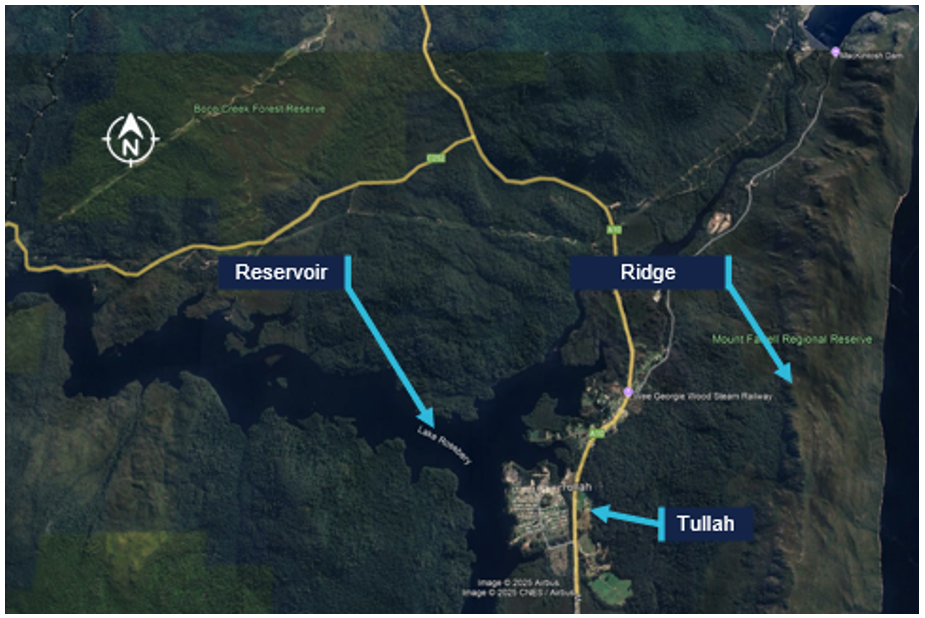What happened
On the morning of 17 July 2024, a Bell helicopter operating under VFR[1] departed a private airfield at Creasy, Tasmania for an external sling load operation in the town of Tullah. The helicopter was crewed by 2 pilots, with the copilot as pilot flying (PF).
Tullah is characterised by a high ridge to the east of the town and a reservoir to the west. As the helicopter arrived over Tullah, the crew observed significant fog over most of the town, from the reservoir to the ridge.
Figure 1: Aerial image of Tullah and surrounds

Source: Google Earth, modified by the ATSB
The crew discussed the available options to land at Tullah and the pilot in command (PIC) suggested that the best option would be to approach from the west, over the reservoir, where the edge of the town was visible. The copilot did not agree with the decision to continue the flight, so the PIC took over as PF to conduct the approach.
The PIC reported that as the sun was low on the horizon and the water was glassy calm, there was a reflection of the edge of town and trees along the reservoir, reducing their depth perception. Due to a concern with possibly flying into the water, the PIC planned to conduct a slow and steep approach towards the reservoir. The PIC anticipated that they would become visual with the water at approximately 100–200 ft, aided by the rotor downwash disturbing the water surface. They would then use this as a height reference, then climb back to 500 ft to continue to the edge of town for further descent.
Video footage received by the ATSB from a third party shows the helicopter descended toward the water in fog. The PIC reported that during the descent, the rotor downwash was not visible to the crew due to the descent angle, and although the crew had the edge of the reservoir in sight, they lost visual reference with the water. At approximately 5 ft above the water, the crew identified the water surface and the PIC immediately applied power to stop the descent and initiate a climb. The PIC reported that before the descent could be arrested, the skids contacted the water. Video footage showed the helicopter making a significant splash. The helicopter subsequently climbed to 500 ft.
The crew returned the helicopter to overhead Tullah and while they considered further options for landing, conditions eventually cleared sufficiently for a landing at the edge of the town.
Safety message
Crew resource management (CRM) plays an important role in communication and decision‑making in a 2‑pilot cockpit. An informed and coordinated approach to decision‑making is essential for ensuring the most appropriate action is taken, especially in non‑normal or high workload situations.
In this instance, the controlled flight into water could have been avoided if the crew had followed effective CRM procedures when considering options for an approach over still water and with fog in the area.
About this report
Decisions regarding whether to conduct an investigation, and the scope of an investigation, are based on many factors, including the level of safety benefit likely to be obtained from an investigation. For this occurrence, no investigation has been conducted and the ATSB did not verify the accuracy of the information. A brief description has been written using information supplied in the notification and any follow-up information in order to produce a short summary report, and allow for greater industry awareness of potential safety issues and possible safety actions.
[1] Visual flight rules (VFR): a set of regulations that permit a pilot to operate an aircraft only in weather conditions generally clear enough to allow the pilot to see where the aircraft is going.


